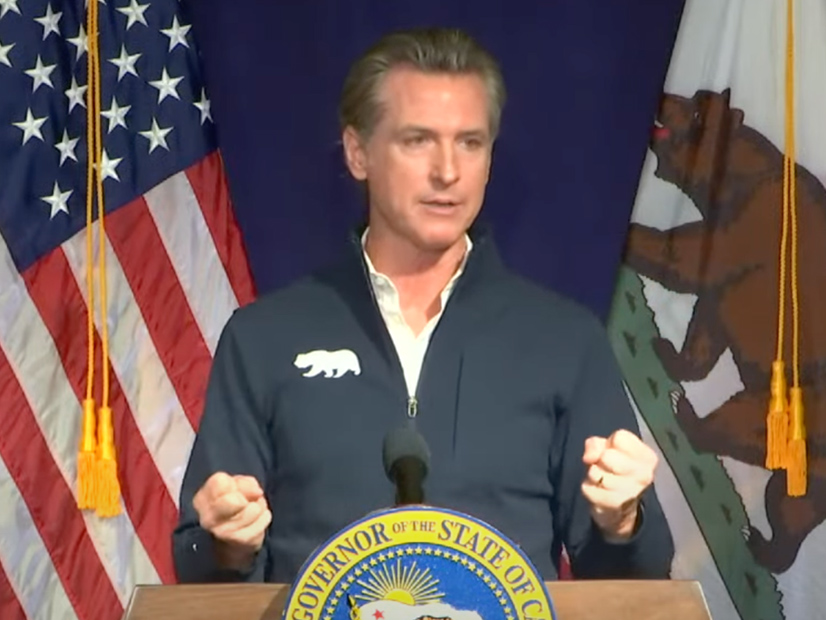California Gov. Gavin Newsom on Tuesday presented his fiscal year 2023/24 budget plan, which proposes eliminating $6 billion in funding for clean transportation and other climate initiatives because of a projected plunge in tax revenue caused mostly by the declining value of technology stocks.
The cuts would reduce last year’s $54 billion five-year commitment for climate initiatives to $48 billion, maintaining 89% of last year’s historic funding levels. Even reduced, the amount represents the world’s largest climate pledge at a “sub-national level,” Newsom said.
California could still see billions of dollars from the federal Inflation Reduction Act (IRA), “not only filling that bucket back up but substantially increasing the total investment,” and that’s the reason why climate and transportation were targeted for some of the largest cuts in this year’s budget, the governor said.
If financial conditions improve, the budget proposes a $3.9 billion “trigger” mechanism to restore much of the reduced spending in FY 2024/25, Newsom noted. A recession, however, could require even deeper budget cuts in the May revision of the budget plan, he said.
The governor’s budget summary details the financial conditions that made it necessary to reduce overall state spending next fiscal year.
“As 2023 begins, risks to the state’s economic and revenue outlook highlighted in the 2022 budget have been realized — continued high inflation, multiple federal reserve bank interest rate increases, and further stock market declines,” it says. “This last risk is particularly important to California, as market-based compensation — including stock options and bonus payments — greatly influences the incomes of high-income Californians. Combined with a progressive income tax structure, this can have an outsized effect, both good and bad, on state revenues.”
The state’s revenue outlook is “substantially different than … in the last two years” of record surpluses, it notes. The governor’s budget forecasts that state general-fund revenues will be $29.5 billion lower than in 2022/23.
“California now faces an estimated budget gap of $22.5 billion in the 2023-24 fiscal year,” it says.
Bond sales or withdrawals from the state’s budget reserves could offset further reductions, it says. In 2014 voters approved Proposition 2, requiring funding upgrades to the state’s Budget Stabilization Account, known as the rainy day fund. To make withdrawals, the governor must declare a state of emergency.
The account now holds $22.4 billion and constitutes the largest portion of the state’s $35.6 billion in total budget reserves, the budget proposal says.
Major cuts proposed in the governor’s budget include a $1.1 billion reduction in the state’s $10 billion, five-year commitment to funding for light-, medium- and heavy-duty zero-emission vehicles that was adopted in the past two fiscal years.
“The budget maintains $8.9 billion (89%) of ZEV investments with a focus on communities that are the most affected,” the budget summary says. “This includes targeted investments in disadvantaged and low-income communities by increasing access to the benefits of clean transportation and by continuing to decarbonize California’s transportation sector and improve public health.”
In addition, it proposes $2.5 billion in “reductions across various ZEV programs, which are partially offset by approximately $1.4 billion in fund shifts to cap-and-trade funds.
“Further, the administration will pursue additional federal funding to help offset the decrease in state funds,” it says. “For example, the federal IRA includes $100 billion to states for clean energy and climate investments. The administration will continue to aggressively pursue this federal funding.”
Some proposed program cuts include:
- A reduction of $745 million in state general fund dollars for programs that “expand affordable and convenient ZEV infrastructure access in low-income neighborhoods.” The cuts would be “partially offset by a shift of $535 million to the Greenhouse Gas Reduction Fund. This maintains approximately $2.1 billion (91%) for programs,” according to the budget summary.
- A $1.5 billion general fund reduction for programs that support drayage trucks, transit buses and school buses, “which is partially offset by a shift of $839 million to the Greenhouse Gas Reduction Fund. This maintains approximately $5.3 billion (89%)” of the original funding,” it says.
- A $270 million cut to the California Public Utilities Commission’s residential solar and storage program. “This maintains approximately $630 million (70%) for solar and storage incentives for low-income utility customers,” the budget summary says.
- A reduction of $50 million from the long-duration energy storage program at the California Energy Commission. “This maintains approximately $330 million (87%) for support of long duration energy storage projects that will help with the state’s energy transition,” it says.


